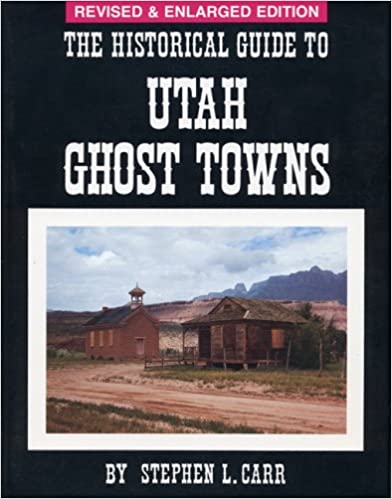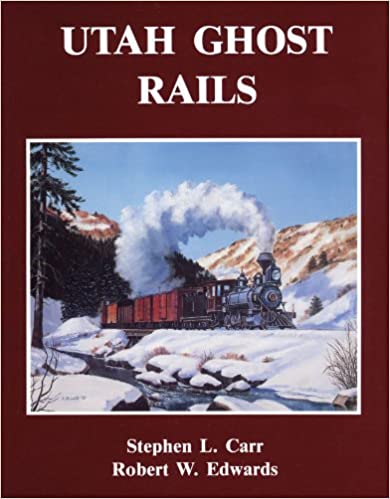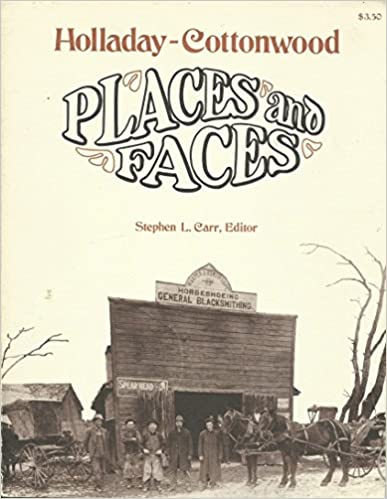Many people relate ghost towns to old mining camps whose ore veins ran out, then the inhabitants did. Utah has a goodly number of such places but also has a great number of agricultural towns which were abandoned for one reason or another. Generally the reason was water, either too much of it – several towns were literally flooded away, or drought – for many villages streams ran dry or water tables dropped, the surrounding farms withered eventually driving the townsfolk to other more suitable locations.
Stephen L. Carr, Forward
Synopsis
The Historical Guide to Utah Ghost Towns by Stephen L. Carr, published in 1972, is one of the many resources within the Park City Room. Browse this book to find essential Utah history or inspiration for an adventurous “state”-cation road trip.
This guide is a compilation of histories of over 150 Utah ghost towns. Carr drew upon records from the Utah State Historical Society, the Utah Mining Association, the Historical Department of the Church of Jesus Christ of Latter Day Saints, and many more organizations. Carr also includes stories from who we may call “old timers” who lived in many of these towns or knew the early history from word of mouth. This book is an intriguing look into the early history of Utah, stories of towns that almost were, and some towns – like Park City – that overcame the title of “ghost town.”
Carr defines a ghost town as “shadowy remains of a town’s former life and activity, even though in some instances a particular town may still be quite active.” Each ghost town is assessed by Carr’s classification system by type (mining, agricultural, railroad, and miscellaneous) and class (from completely disappeared to buildings still standing) of ghost towns.
You may be surprised to find Park City is one of the ghost towns. When the book was written in 1972, Park City was considered a Class 7 mining ghost town. The book highlights an 1868 story of three soldiers who, while exploring the high mountains, discovered ore bearing quarts. To mark the location the soldiers tied a red bandana on a bush so they could find the spot again, which gave this newly discovered mine the name of Flagstaff Mine. Many considered this the greatest silver mine in the world which would bring many prospectors to Park City.
About the Author
Stephen L. Carr (1937-2014) was born and lived most of his life in Salt Lake City. When in the U.S. Army Signal Corps, he was part of the Atomic Bomb testing that took place in Nevada. As an author part-time, he owned a pediatrics practice for 30 years. His LDS religion was very important to him and he served many roles within the Church. He helped with the start the Heber Creeper Railroad and Heber Valley Historic Railroad Authority. After his retirement, he was a volunteer train conductor.
More Books by Stephen L. Carr
History of abandoned railroads and branch lines in Utah plus interurbans, streetcars and tramways. The book is divided into six sections, each covering an area of the state, with the lines in each county described in detail. There are dozens of lines described, with explanations of how they came into existence, their history and why they were abandoned. It’s fascinating to see how many Union Pacific and Central Pacific branch lines once existed. Illustrated throughout with vintage black and white photos showing the lines in action and, often, what remains now. With several maps. An invaluable reference work for anyone interested in Utah or railroad history.
This book was produced by a committee planning the “Holladay-Cottonwood Heritage” week that took place on June 19-26, 1976. One of their goals was to “research and produce a book relating the history of Holladay and the Cottonwoods.” Their book acknowledges that while this book is not expanse of the history, it attempts “a more informal treatment to touch as many facets as possible of the area’s life – both early and recent, in written and pictorial form.” The book covers the time span of 1776-1976.
The Park City Room
The Park City Room is a special collection located on the second floor of the Park City Library. The Park City Room’s collection is curated to sustain, encourage, and promote the legacy of Park City’s cultural and environmental heritage. The collection includes Park City and Utah focused books, movies, reports, and more. The Park City Room collection is for visitors’ reference and items can be viewed at the library, but cannot be checked out. Some items, including this title, are available for checkout from the library’s main collection. If you have inquiries about this collection, reach out to our librarians through Contact Us.
To search the Park City Room Collection in the Library catalog, enter your search term in the search bar. Next, filter results of your search by choosing ‘Park City Collection’ under ‘Collection.’


